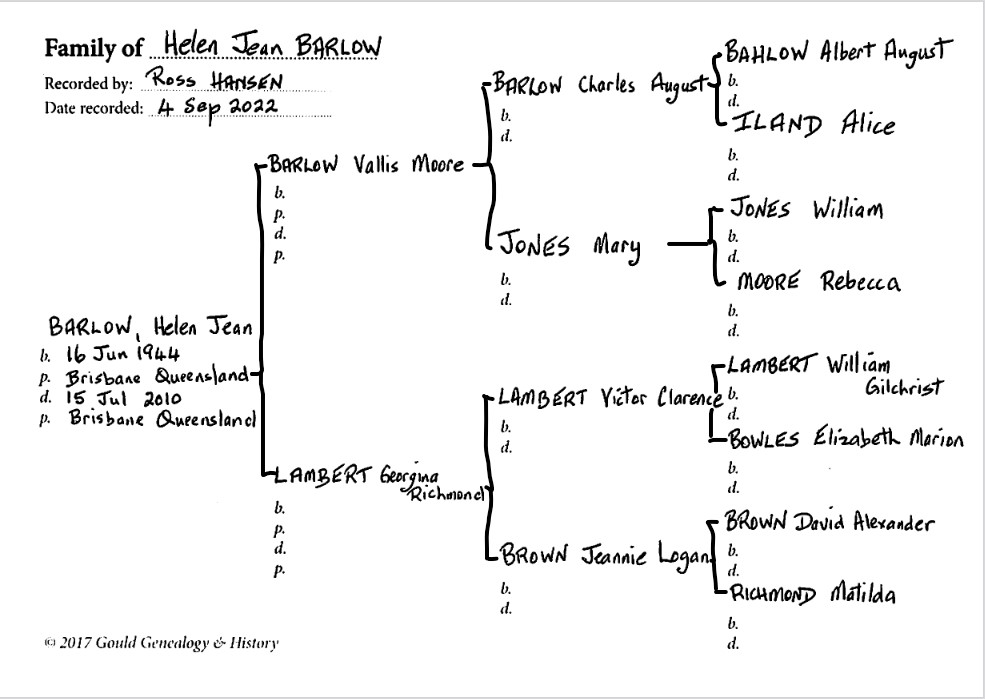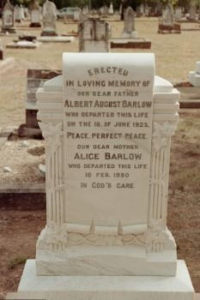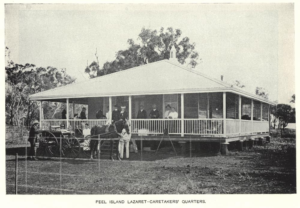Enjoying the next genealogy journey.
My next genealogy journey will be an exploration of my late wife’s family. Her name was Helen Jean Hansen (nee Barlow) and she succumbed to ovarian cancer in 2010. I intend to bring her family and ancestors to life again, figuratively speaking of course, for the benefit of their descendants. But what was my first genealogy journey?
 That journey began in 1983 with an evening course conducted by the Genealogical Society of Queensland (GSQ) at The Gap State School. Given some basic tools like pedigree charts and family group record sheets, we were challenged to fill in as much information as we could gather from living family members and write a brief biography of one of them. That’s how I was first bitten by the bug. Joining GSQ at the time was a great help as I was introduced to the International Genealogical Index (IGI) on microfiche and the GSQ library with all sorts of relevant books and journals, not forgetting those helpful volunteers. But juggling a full-time job, a family with three boys, ageing parents, part-time studies at night and regular parades with Army Reserve all left little time to scratch that genealogy itch. That is, until I retired from paid work in 2012.
That journey began in 1983 with an evening course conducted by the Genealogical Society of Queensland (GSQ) at The Gap State School. Given some basic tools like pedigree charts and family group record sheets, we were challenged to fill in as much information as we could gather from living family members and write a brief biography of one of them. That’s how I was first bitten by the bug. Joining GSQ at the time was a great help as I was introduced to the International Genealogical Index (IGI) on microfiche and the GSQ library with all sorts of relevant books and journals, not forgetting those helpful volunteers. But juggling a full-time job, a family with three boys, ageing parents, part-time studies at night and regular parades with Army Reserve all left little time to scratch that genealogy itch. That is, until I retired from paid work in 2012.
After years accumulating snippets of information about my own ancestors, I became overwhelmed at the prospect of tying it all together into a book that my family would want to read. Some books purporting to be family histories are merely pages of names, dates and places, sometimes with a few photos and usually featuring a fold-out page or two of family trees. These do not make for very engrossing reading. I wanted mine to be different. Like most people in their early attempts at genealogical research, I hadn’t recorded where I found much of this accumulated data, so was constantly going over ground I’d travelled before.
Completing the Diploma of Family History with the University of Tasmania during the two years or so of lockdowns and border closures in 2020/2021 made a difference. It taught me to be better organised, how to cite my sources, to look beyond names, dates and places and explore the lives of those people who had shaped the families before me. It also taught me about writing in a more interesting way. I’ve now revised and reproduced many of my assignments from that Diploma in a photo book to share with family. So, the plan for the next genealogy journey is to follow a similar pattern of research, discovery, and narrative writing. Already, I have questions whose answers may lie in my myriads of notes collected over the years or may still need to be found in forthcoming research.

The Barlow-Bahlow family tree
The first Barlows in my wife Helen’s family in Australia were actually named Bahlow, or in some records, Balow. So, what was their journey like from Hamburg, Germany to Maryborough, Queensland on the ship, Reichstag? Why might they have chosen to leave their homeland in 1870 and what did they do after they arrived?

Tombstone of Alice and Albert August Barlow. Photo in authors collection.
The mother of Vallis Moore Barlow, Helen’s dad, was Mary Jones. Now there’s a challenge – to find the correct William Jones from Wales, who was Mary’s father. And if that is not challenging enough, the mother of Helen’s mum was Jeannie Brown, from Scotland.
Helen’s mother was a Lambert. The first to Australia of the Lamberts in that family, William Gilchrist Lambert, arrived in Sydney, Australia in the mid-1800s from Surrey, England, though on what ship I am yet to discover. To confuse family historians, his father, his son, and his grandson were also named William Gilchrist Lambert. So where did the Gilchrist name come from? Helen’s mother, Georgina, was born on Thursday Island, what was it like growing up there during the early 20th century?
Snippets of information gathered over almost forty years brings many questions to mind about these families. For example, on Helen’s paternal side (Barlow, Jones, Iland and, Moore), would growing up in Wellingborough in Northamptonshire with a father as a shoemaker have been interesting for Rebecca Moore? Like many children at the time, would she have helped her father in his workshop? And would her life have changed much when she married William Jones, a soldier? How did Richard Iland come to accidentally fall into the Mary River in Maryborough and drown? Did Benjamin Jones really fight in the Boer War? Maybe that’s how he seems to have been married in South Africa? May and Alice Barlow each married a Nagel. Would they have been brothers or cousins? It must have been a tough life as a timber getter in the early 1900s for August Bahlow. He was later a dairyman, probably an equally hard life. In the Maryborough Cemetery, I managed to photograph some Barlow headstones.

Peel Island Lazaret – Caretakers Quarters ca 1913. Copyright free from the collection of the State Library of Queensland.
On Helen’s maternal side (Lambert, Brown, Bowles and Richmond), what would life have been like for David Brown and his wife, Matilda Richmond, as caretakers at the quarantine station on Friday Island in Torres Strait and later as attendant and matron at the Peel Island lazaret in Moreton Bay? Getting married in the beautiful Quetta Memorial Cathedral on Thursday Island might have been a special experience for Victor Lambert and Jeannie Brown.
The reader may care to join me on this next journey as I try to put the leaves on the branches of Helen’s family tree (illustrated). I aim to colour those leaves by answering some of these questions, confirming the relationships, filling in the gaps in my present knowledge and, of course, properly documenting it all for the first time. I can’t promise to have or find all the answers, but I hope to enjoy the journey as much as I did when researching my own Hansen/Wallace ancestors during the Diploma of Family History.
In writing this, my first ever blog, I aim to document my research process, its ups and downs, successes, and failures. But I also hope to hone my writing skills so that readers will want to read beyond the first paragraph and the next ones, until they reach the end. Will you join me?

How exciting to be starting a new voyage of discovery. Good luck with it.
Thank you, Di. Along the way, I hope readers might learn from my mistakes. My challenge is to try to keep it interesting.
Thank you for an engaging introduction, I look forward to reading more about this interesting family.
Thank you, Rosemary. The next two episodes have been accepted for publication and will reveal some surprising finds so far.